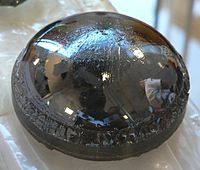
Photo from wikipedia
Abstract Silicon carbide is widely appreciated for its high temperature strength, radiation tolerance and neutronic transparency in applications for fuel particles and core internals of nuclear reactors. In the Fluoride… Click to show full abstract
Abstract Silicon carbide is widely appreciated for its high temperature strength, radiation tolerance and neutronic transparency in applications for fuel particles and core internals of nuclear reactors. In the Fluoride Salt-Cooled High Temperature Reactor, silicon carbide ceramic matrix composites are candidate construction material for regions of higher neutron fluxes. Silicon carbide is wettable and reacts electrochemically with dissolved metals. Metallic impurities, tritium, moisture-based impurities and fission products, as well as thermal gradients can accelerate hot corrosion of silicon carbide in molten fluoride salt. Tritium can become trapped in radiation defects of silicon carbide. Thus, an understanding of the potential for tritium absorption, impurities reactions and thermal gradient-assisted corrosion mechanisms along with tritium recovery and redox control systems are necessary to mitigate silicon carbide corrosion in molten fluoride salt systems. Here, we survey current research on silicon carbide corrosion in molten fluoride salts and critically evaluate the research and development gaps.
Journal Title: Journal of Nuclear Materials
Year Published: 2019
Link to full text (if available)
Share on Social Media: Sign Up to like & get
recommendations!